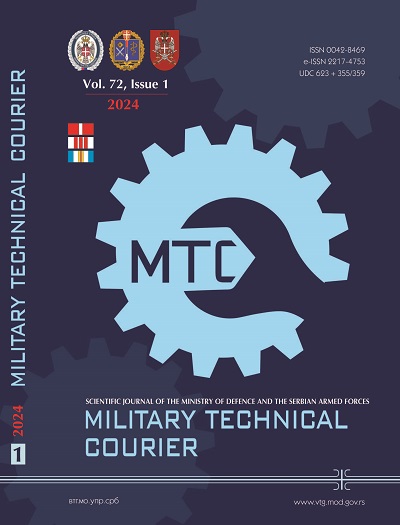Analysis of packet switching in VoIP telephony at the command post of tactical level units
Abstract
Introduction/purpose: This paper conducts a comprehensive analysis of a potential implementation of Voice over Internet Protocol (VoIP) systems, focusing on network architecture, VoIP phones, and servers. The study explores potential vulnerabilities and proposes solutions. The paper concludes by advocating for a holistic approach to securing VoIP systems, incorporating supplementary services to ensure the confidentiality, integrity, and availability of voice communications in the digital landscape.
Methods: Review of the underlying theory, analysis of the end-user needs and potential solutions, practical viability assesment.
Results: The theoretical points discussed were proven in practice, using commercially available resources. Communication was established in an expected manner.
Conclusions: Implementing solutions similar to the one presented in the paper would be a relatively inexpensive way to make diverse improvements to the operation of tactical level units, both in peacetime and during war.
References
Abualhaj, M.M., Al-Tahrawi, M.M. & Al-Zyoud, M. 2021. Contracting VoIP Packet Payload Down to Zero. Cybernetics and Information Technologies, 21(1), pp.137-150. Available at: https://doi.org/10.2478/cait-2021-0010.
Ahmad, B., Gilani, S.A., Iqbal, R., Sherazi, H. & Iranmanesh, V. 2015. Deployment of VoIP Communications in B&A Spy Agency: Design and Implementation. International Journal of Computer Networks and Communications Security, 3(11), pp.424-431 [online]. Available at: https://ijcncs.org/published/volume3/issue11/p3_3-11.pdf [Accessed: 20 October 2023].
Ali, M.A., Rashid, I. & Khan, A.A. 2013. Selection of VoIP CODECs for Different Networks based on QoS Analysis. International Journal of Computer Applications, 84(5), pp.38-44. Available at: https://doi.org/10.5120/14575-2702.
Bhattacharjee, P.K., Koner, C., Bhunia, C.T. & Maulik, U. 2010. Biometric Entity Based Mutual Authentication Technique for 3-G Mobile Communications. International Journal of Computer Theory and Engineering, 2(1), pp.26-30. Available at: https://doi.org/10.7763/IJCTE.2010.V2.111.
Fayyaz, Y., Khan, D.M., Fayyaz, F., Qadri, S., Naweed, S. & Fahad, M. 2016. The Evaluation of Voice-over Internet Protocol (VoIP) by means of Trixbox. International Journal of Natural and Engineering Sciences, 10(3), pp.33-41 [online]. Available at: https://www.ijnes.org/index.php/ijnes/article/view/276/249 [Accessed: 20 October 2023].
Ghini, V., Lodi, G. & Panzieri, F. 2009. Always Best Packet Switching: the Mobile VoIP Case Study. Journal of Communications, 4(9), pp.700-713. Available at: https://doi.org/10.4304/jcm.4.9.700-713.
Marković M. 2023. Analiza paketske komunikacije kod VoIP telefonije na komandnom mestu jedinica taktičkog nivoa. BS thesis. Belgrade, Serbia: University of Defence (in Serbian).
Singh, H.P., Singh, S., Singh, J. & Khan, S.A. 2014. VoIP: State of art for global connectivity - A critical review. Journal of Network and Computer Applications, 37, pp.365-379. Available at: https://doi.org/10.1016/j.jnca.2013.02.026.
Strzeciwilk, D. 2021. Performance Analysis of VoIP Data over IP Networks. International Journal of Electronics and Telecommunications, 67(4), pp.743-750. Available at: https://doi.org/10.24425/ijet.2021.139801.
Thirunavukkarasu, E.S. & Karthikeyan, E. 2015. A survey on VoIP packet loss techniques. International Journal of Communication Networks and Distributed Systems, 14(1). Available at: https://doi.org/10.1504/IJCNDS.2015.066029.
Copyright (c) 2024 Marko R. Marković, Stefan М. Ivanović, Sava S. Stanišić

This work is licensed under a Creative Commons Attribution 4.0 International License.
Proposed Creative Commons Copyright Notices
Proposed Policy for Military Technical Courier (Journals That Offer Open Access)
Authors who publish with this journal agree to the following terms:
Authors retain copyright and grant the journal right of first publication with the work simultaneously licensed under a Creative Commons Attribution License that allows others to share the work with an acknowledgement of the work's authorship and initial publication in this journal.
- Authors are able to enter into separate, additional contractual arrangements for the non-exclusive distribution of the journal's published version of the work (e.g., post it to an institutional repository or publish it in a book), with an acknowledgement of its initial publication in this journal.
- Authors are permitted and encouraged to post their work online (e.g., in institutional repositories or on their website) prior to and during the submission process, as it can lead to productive exchanges, as well as earlier and greater citation of published work (See The Effect of Open Access).

